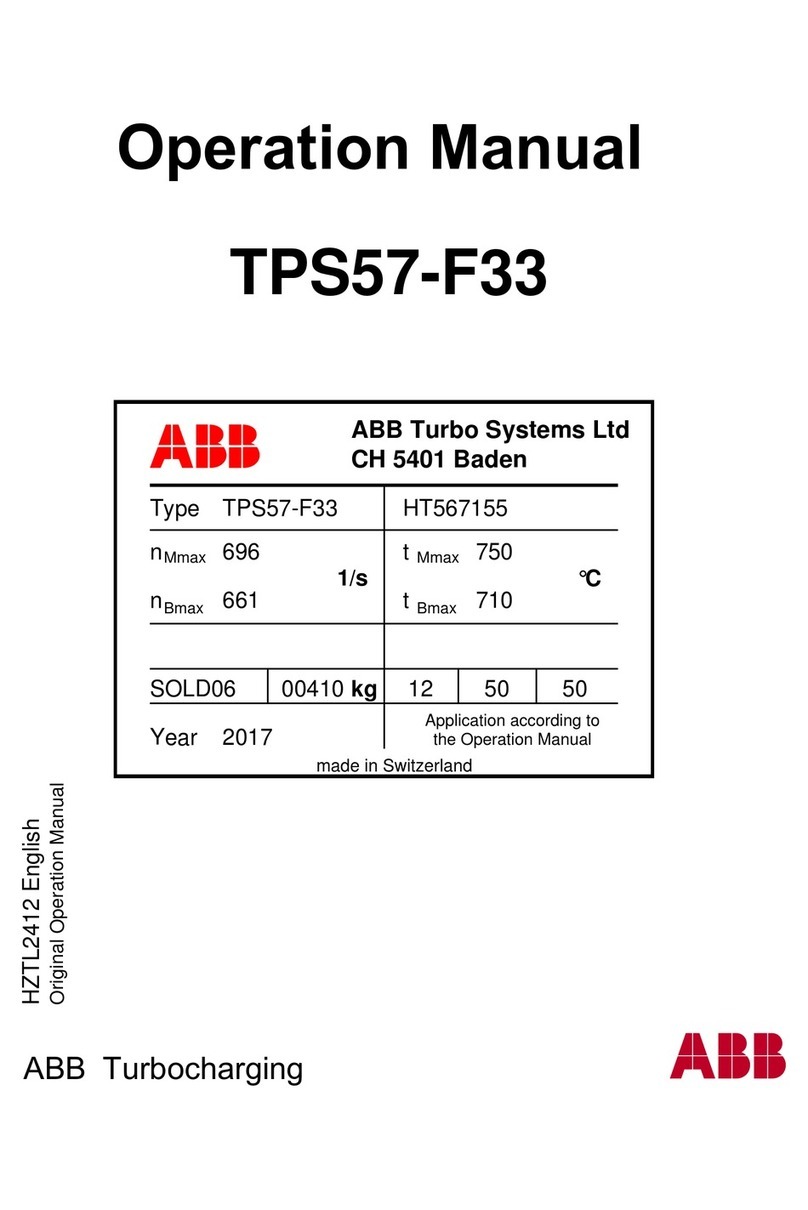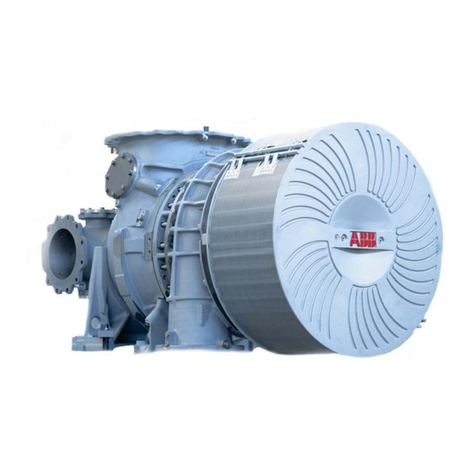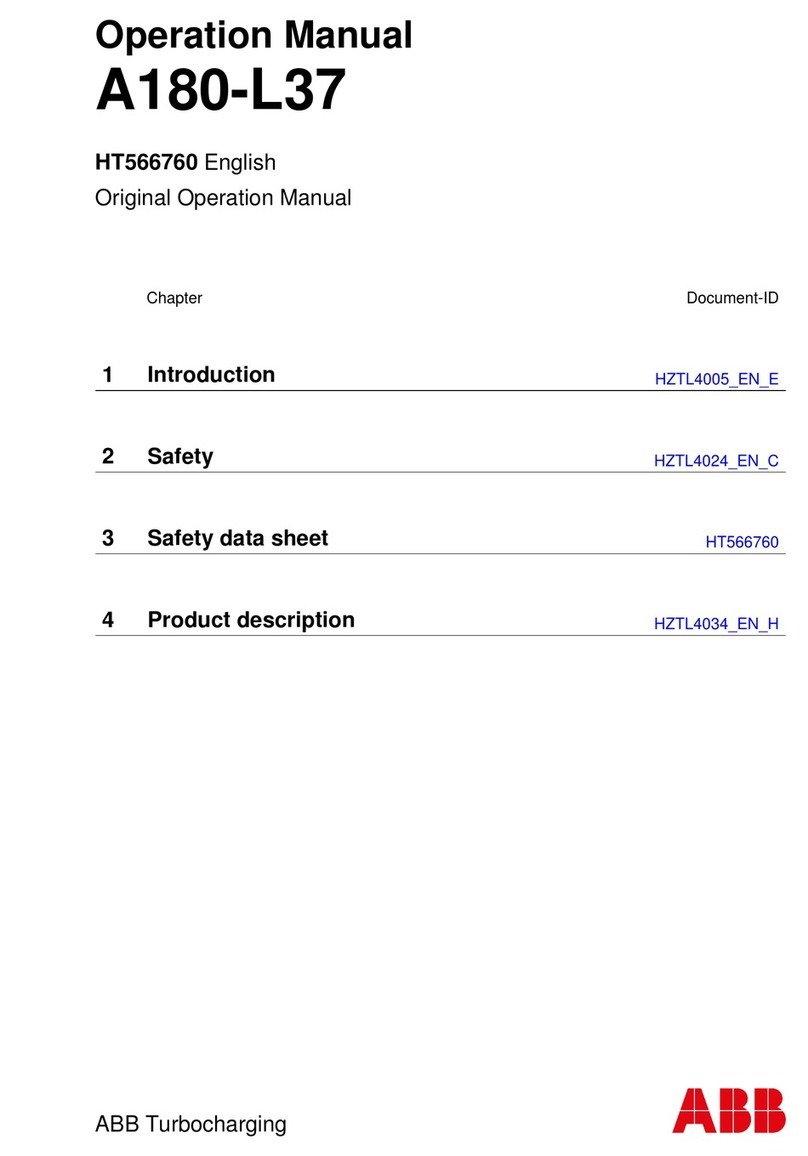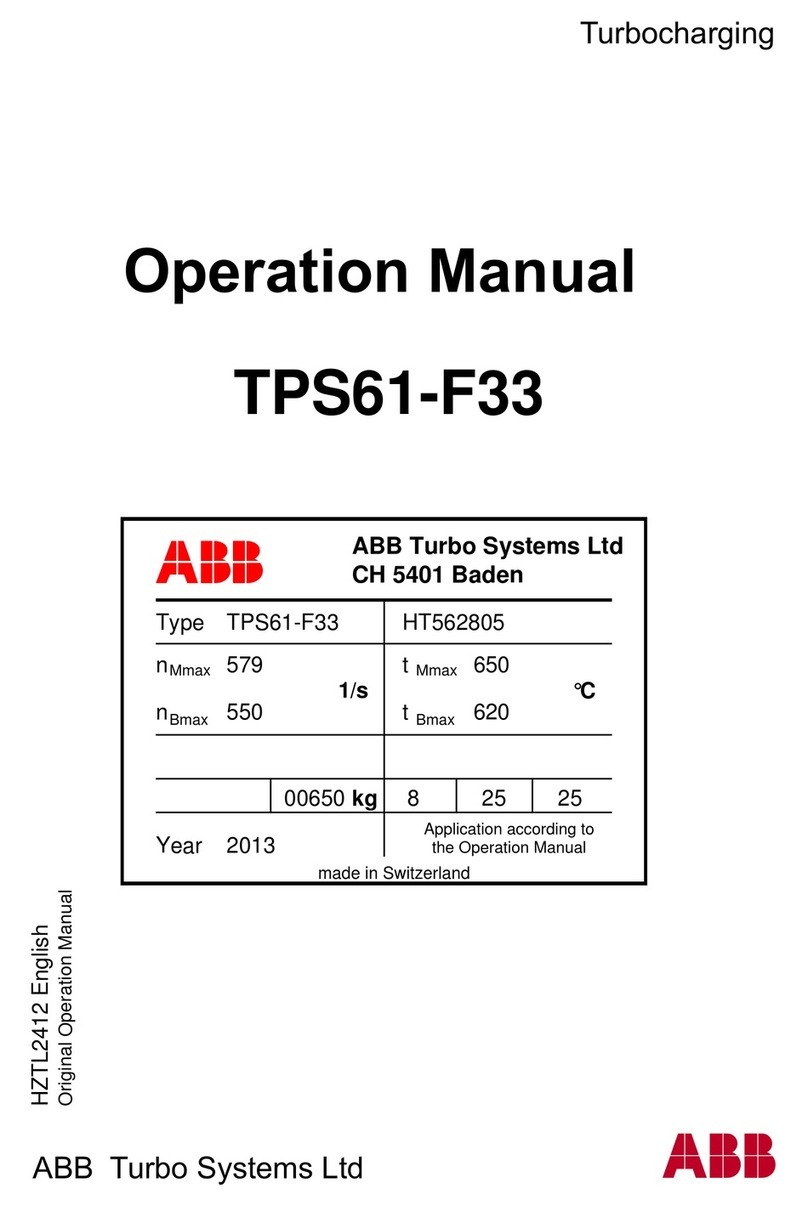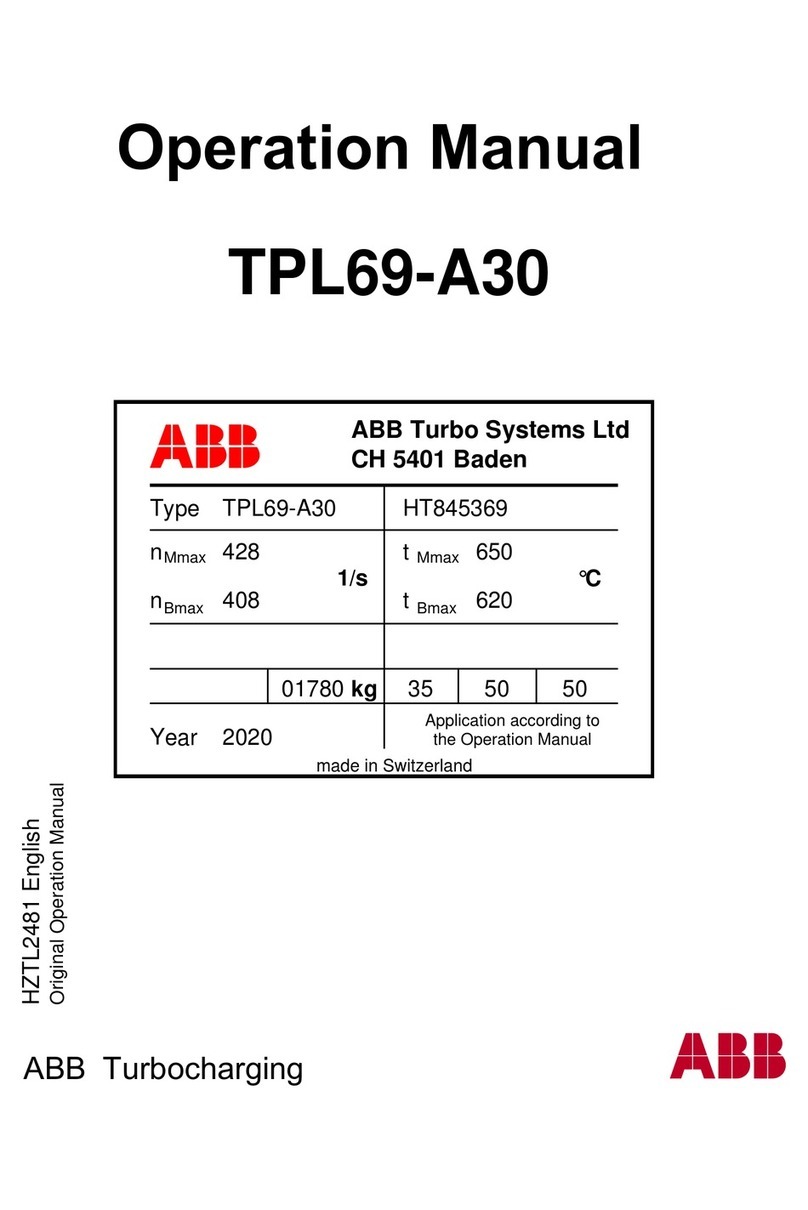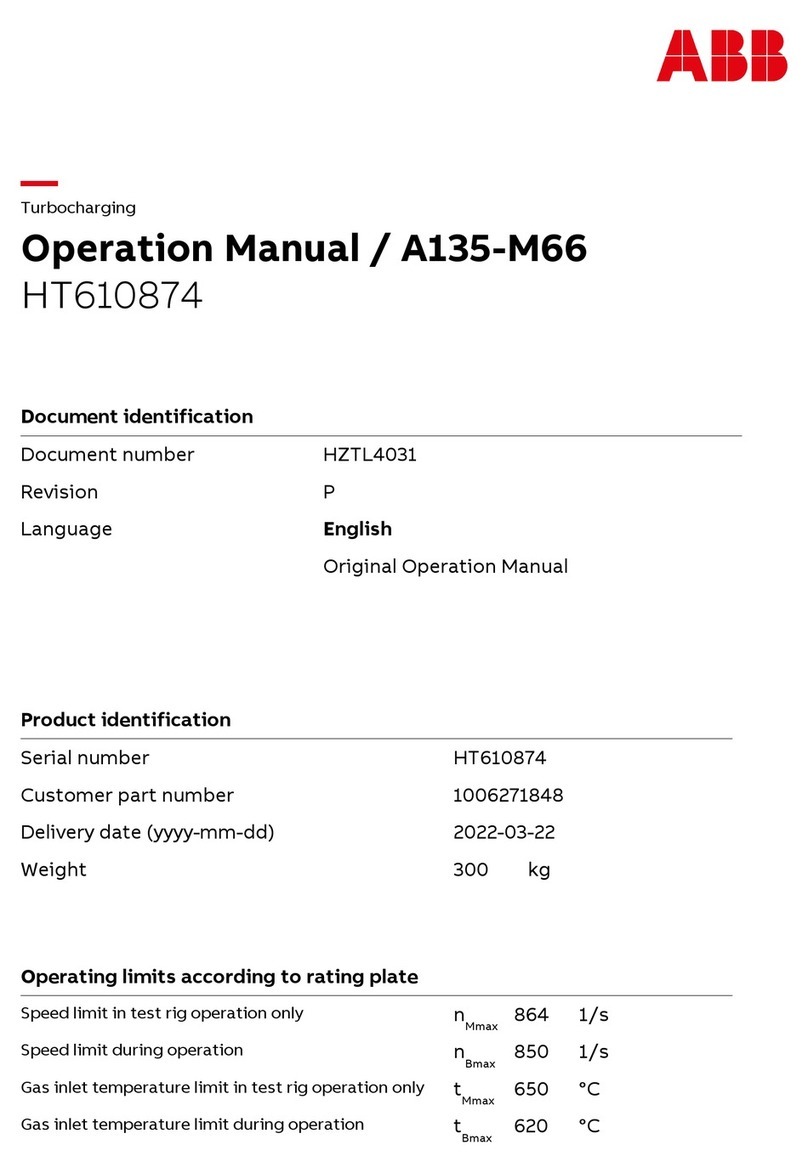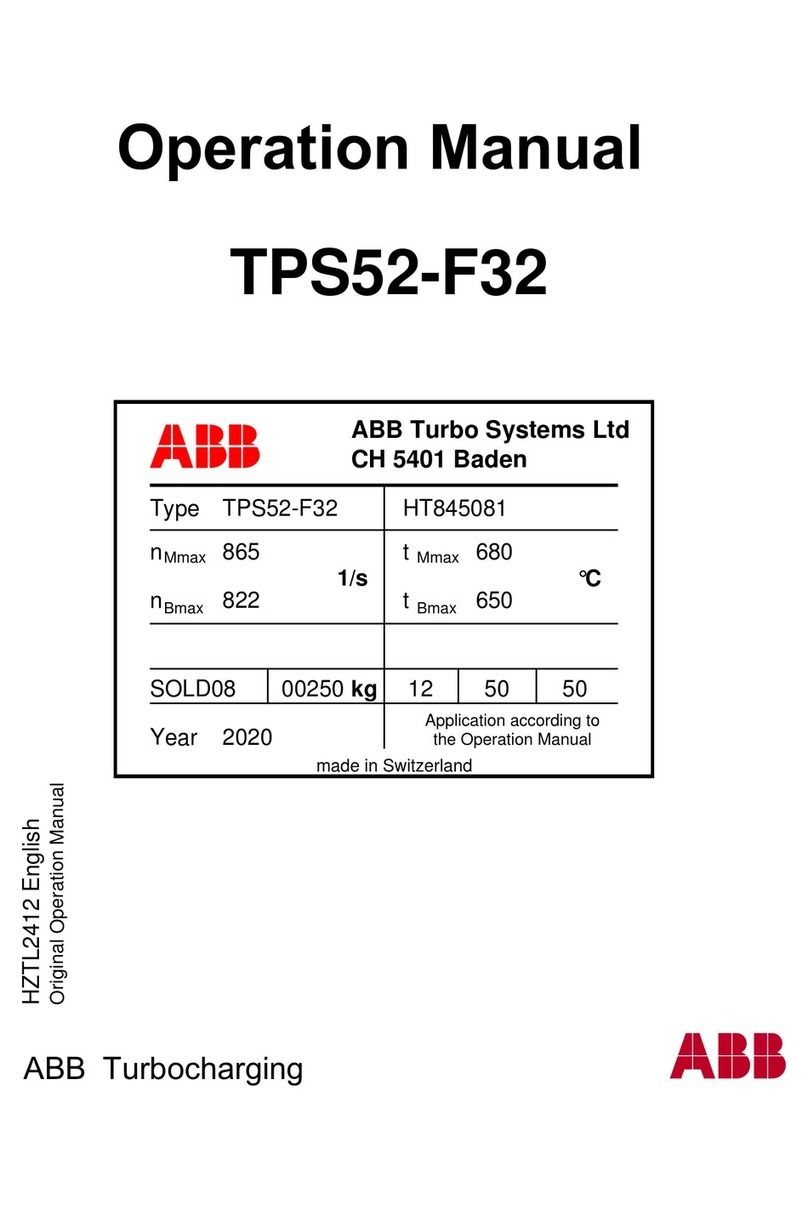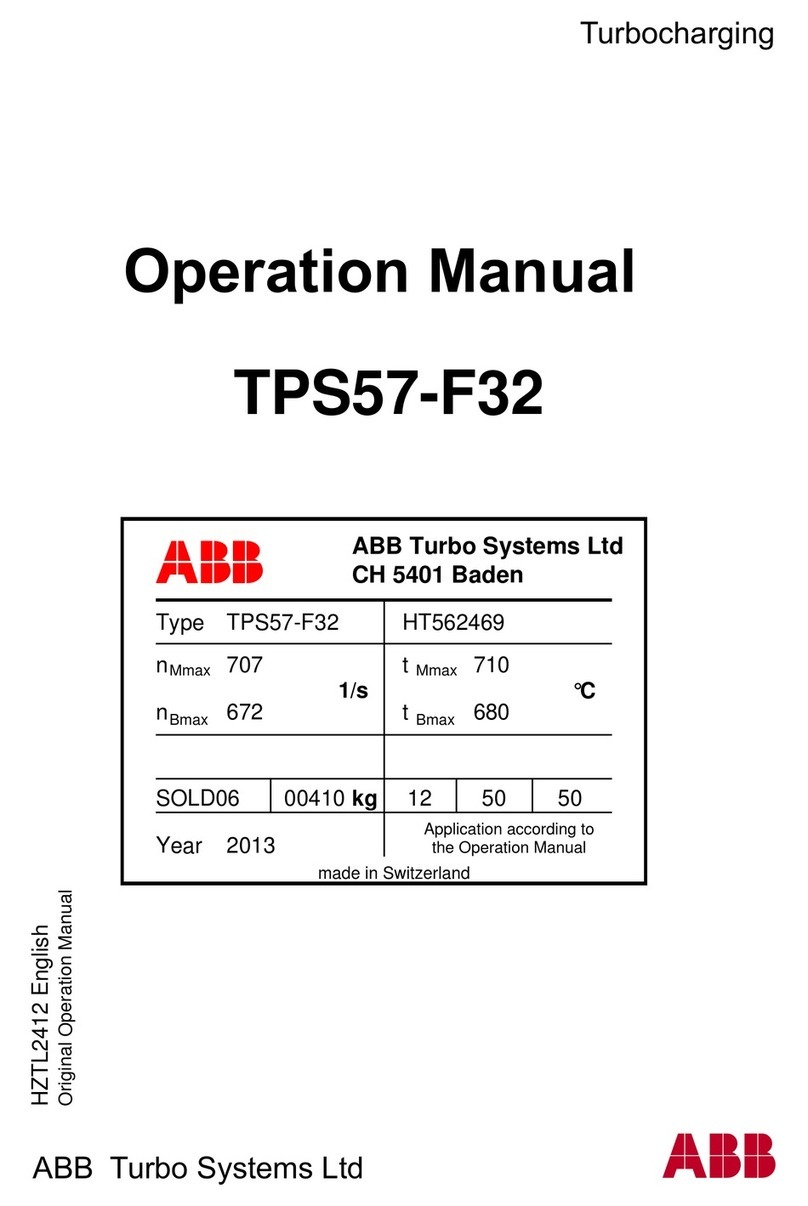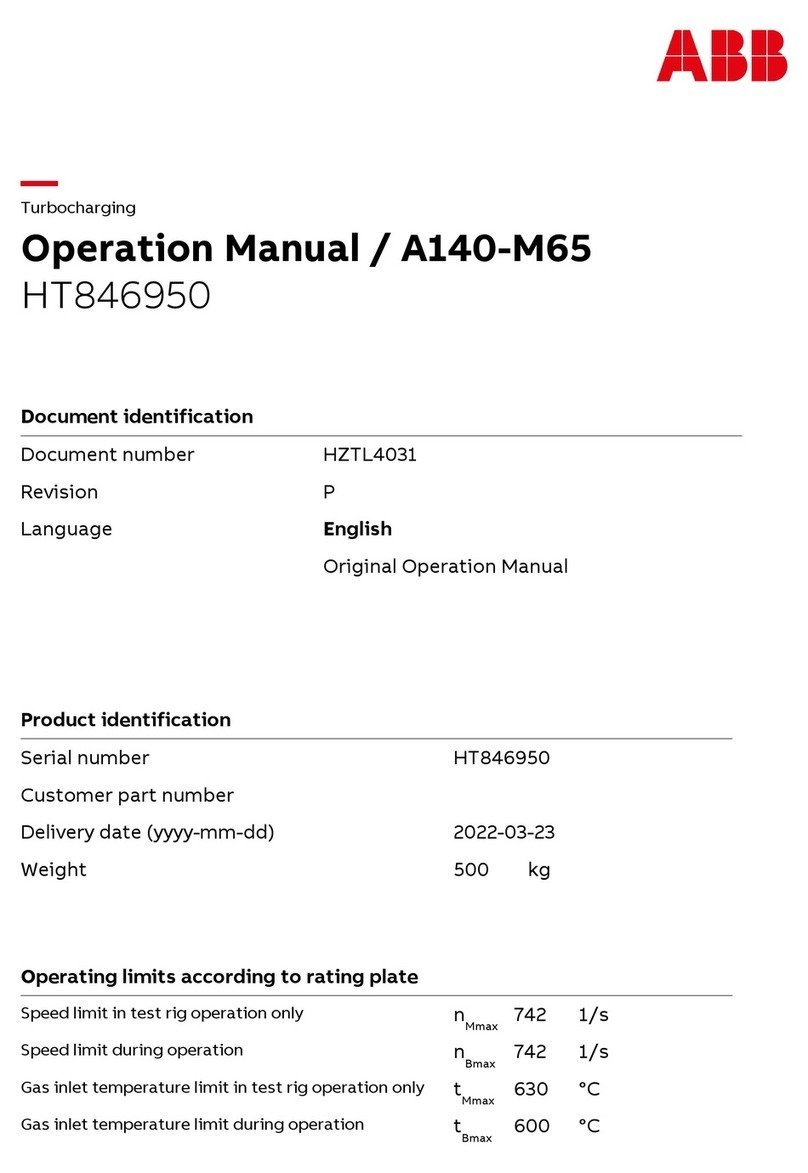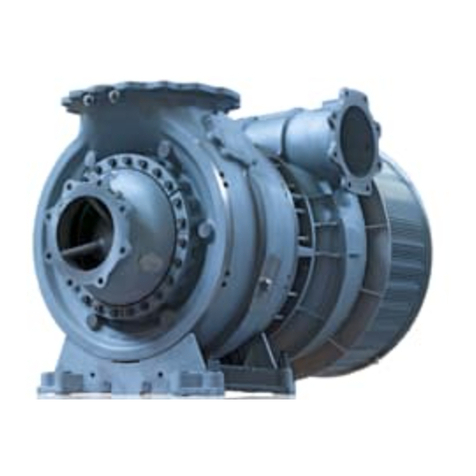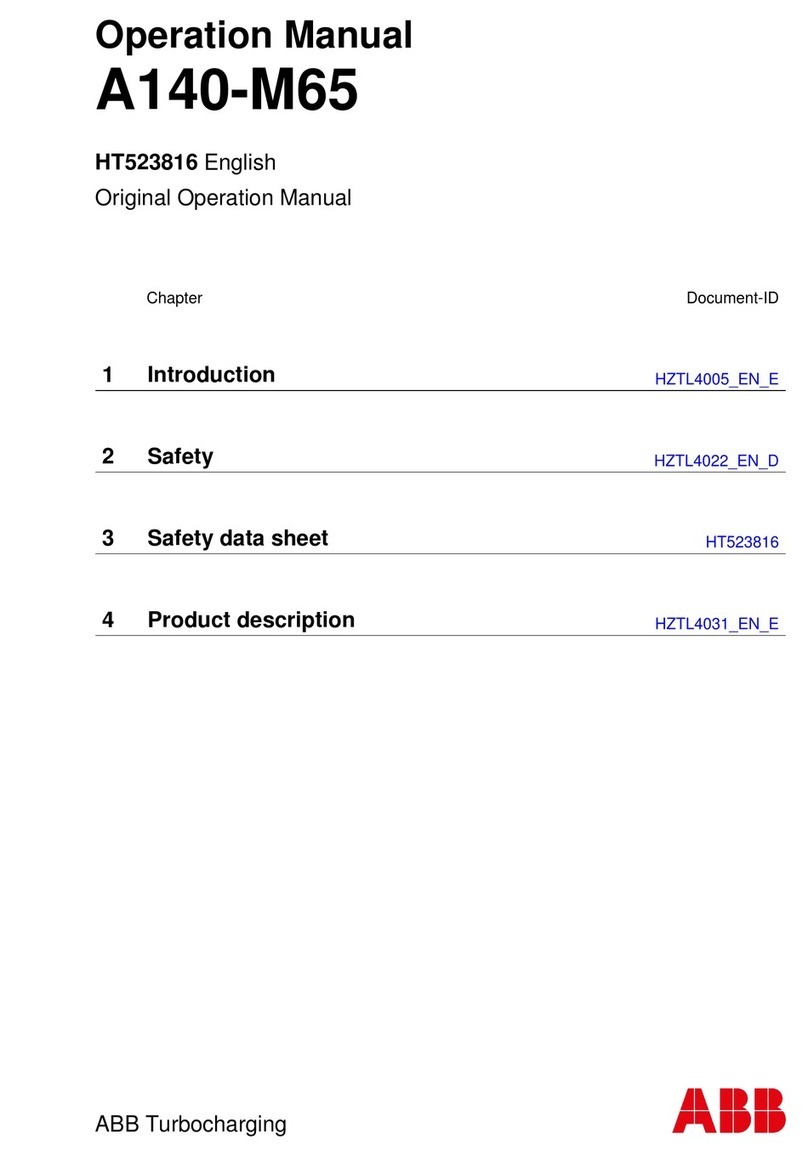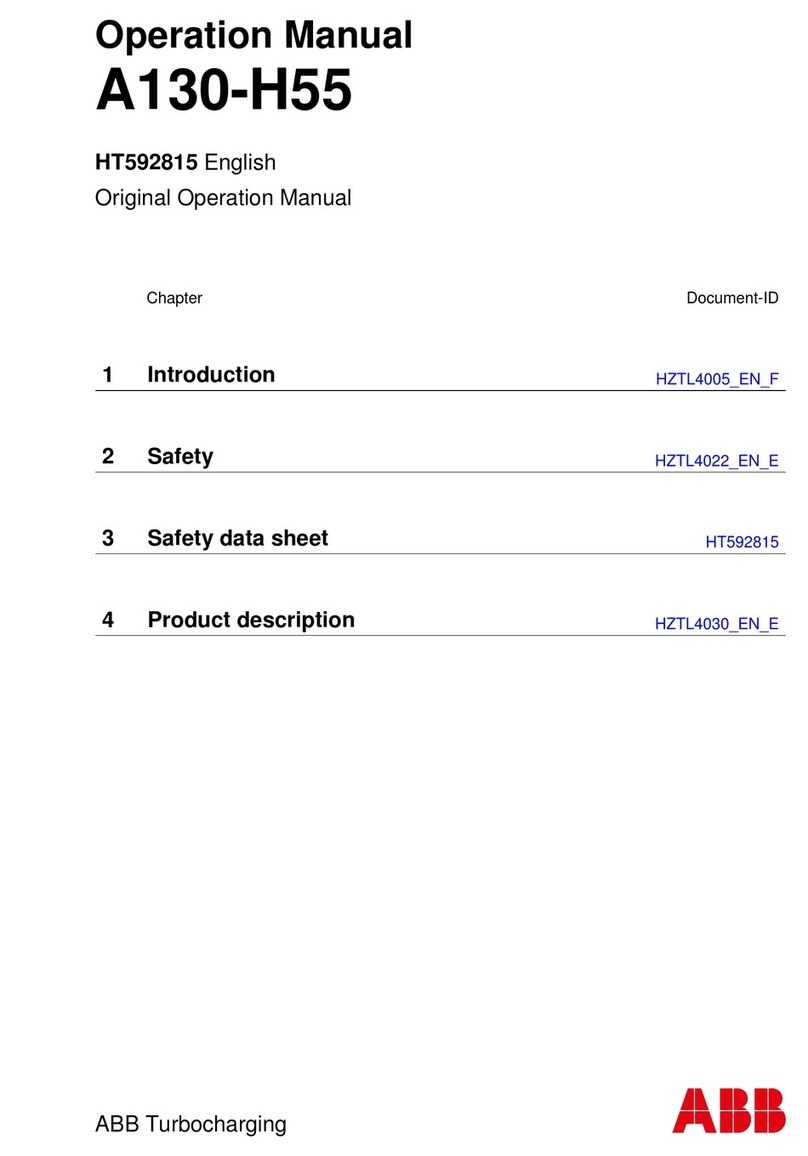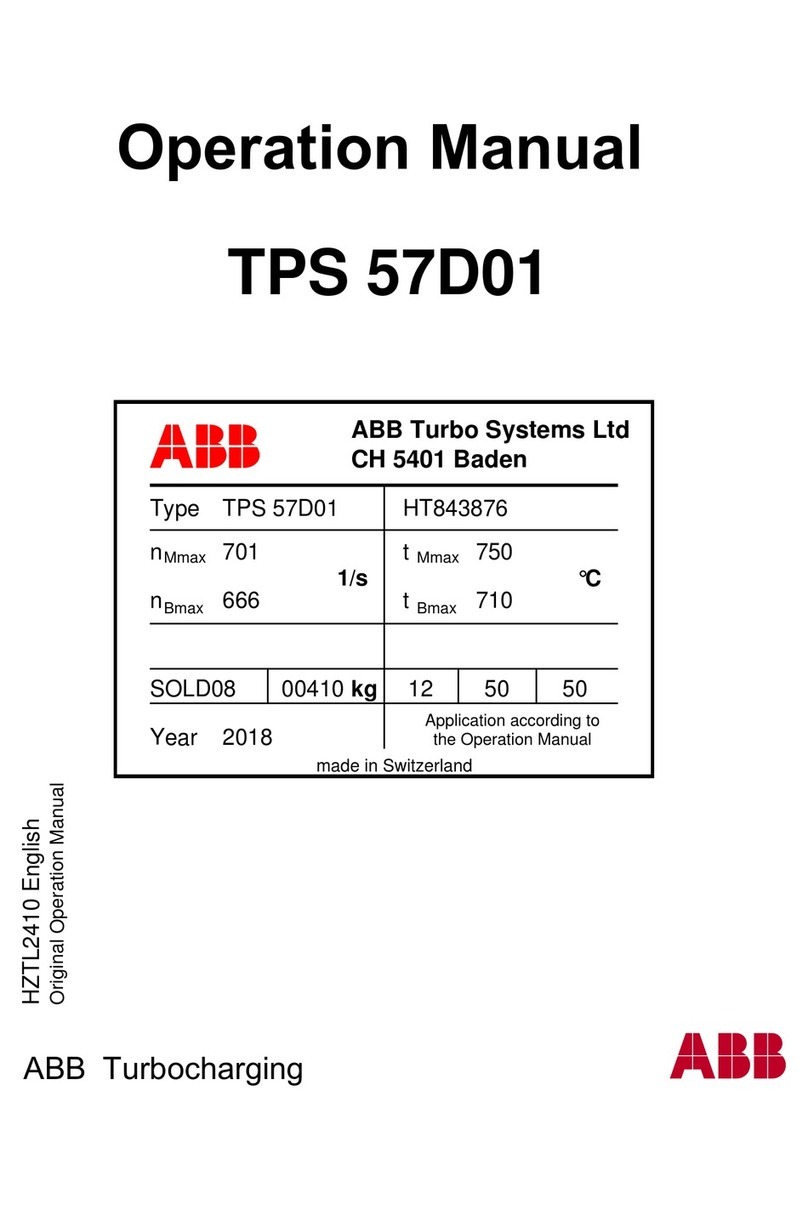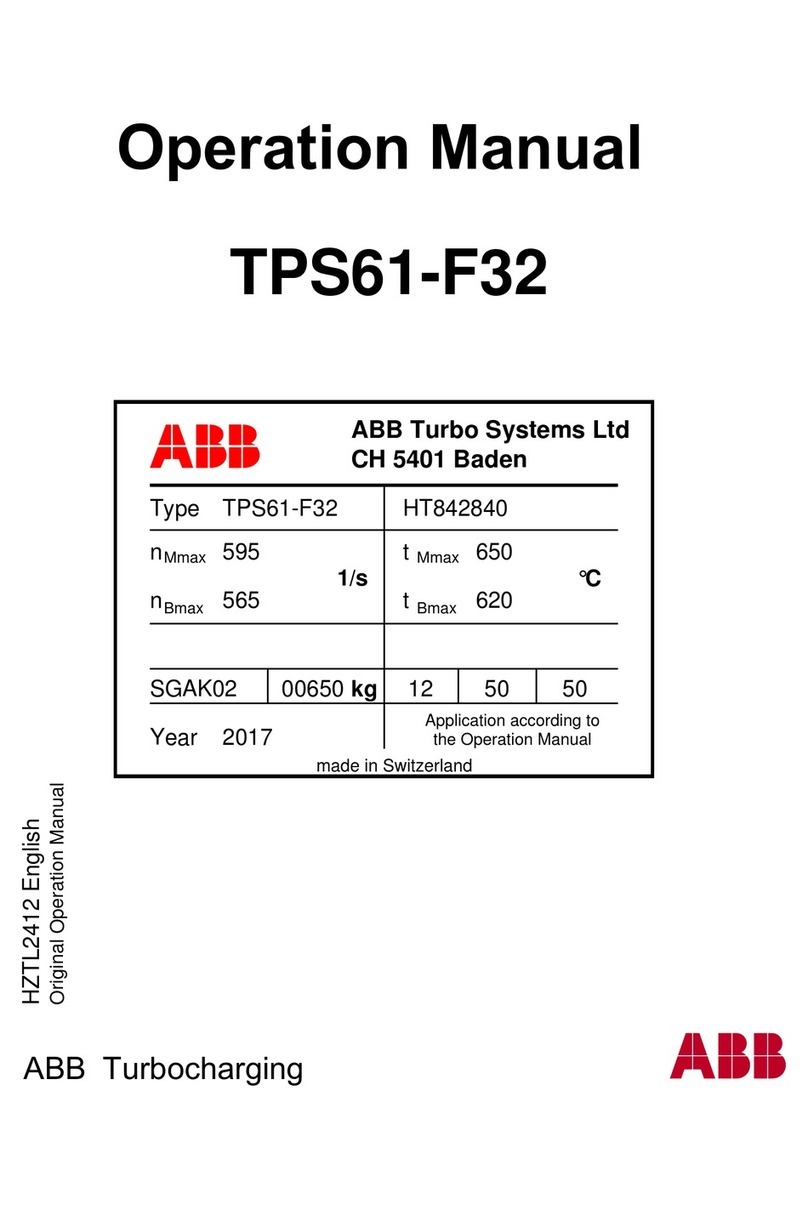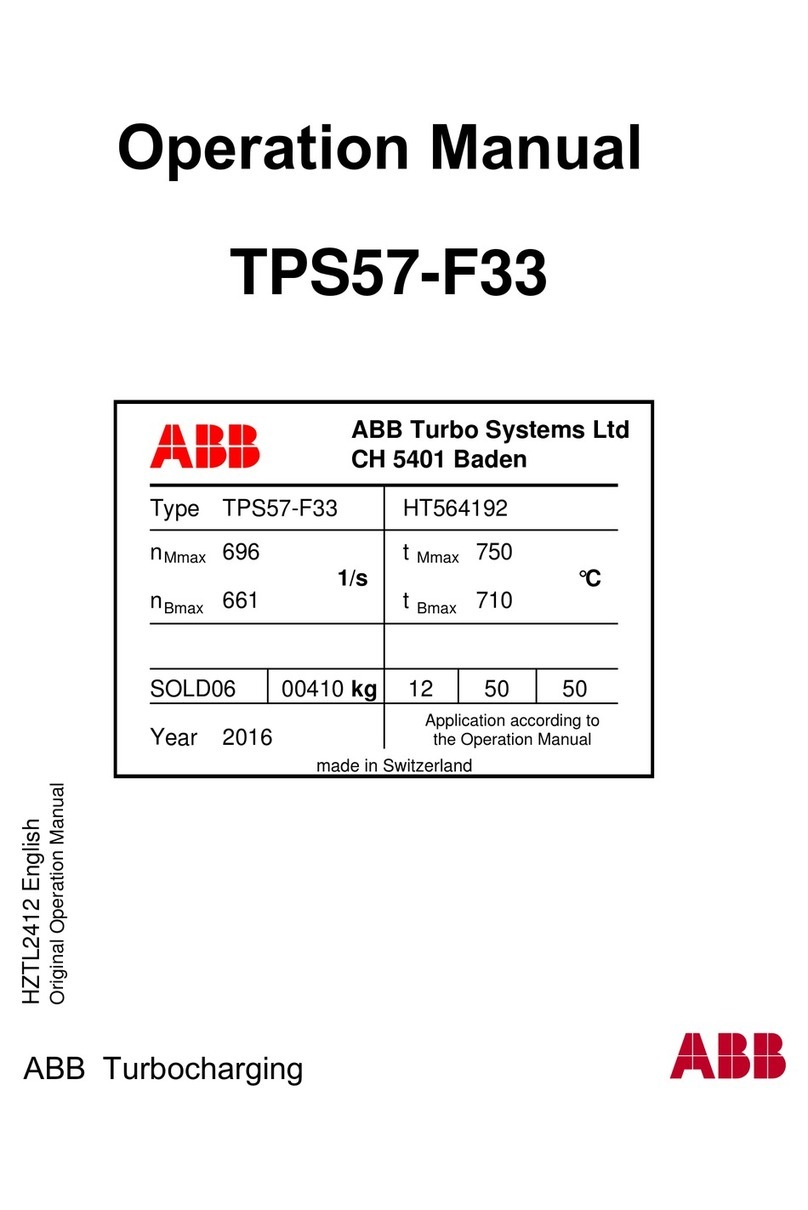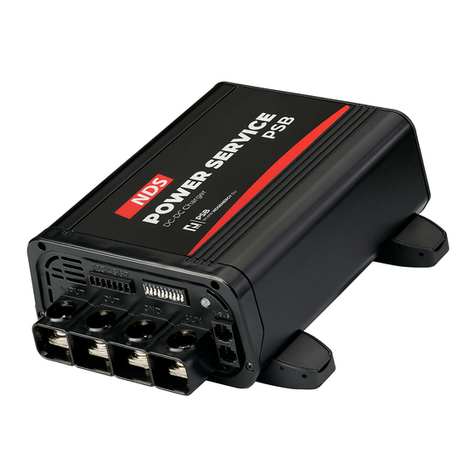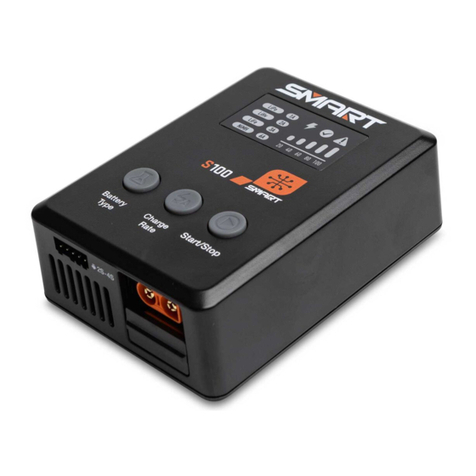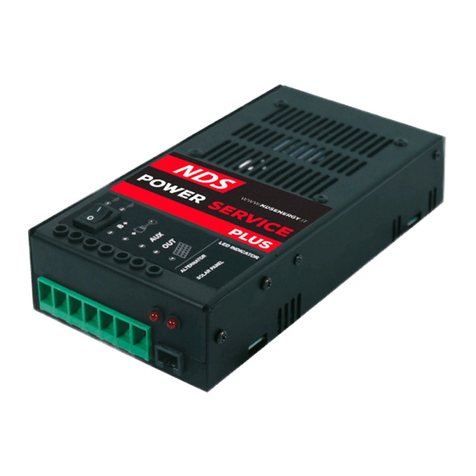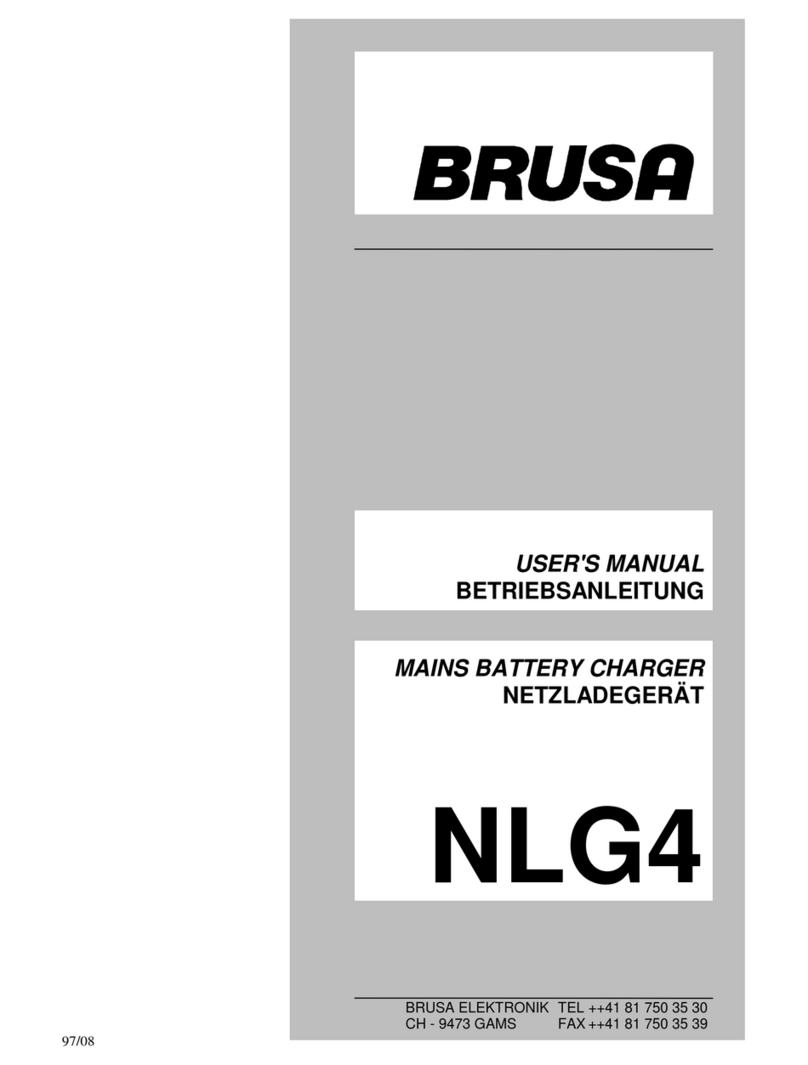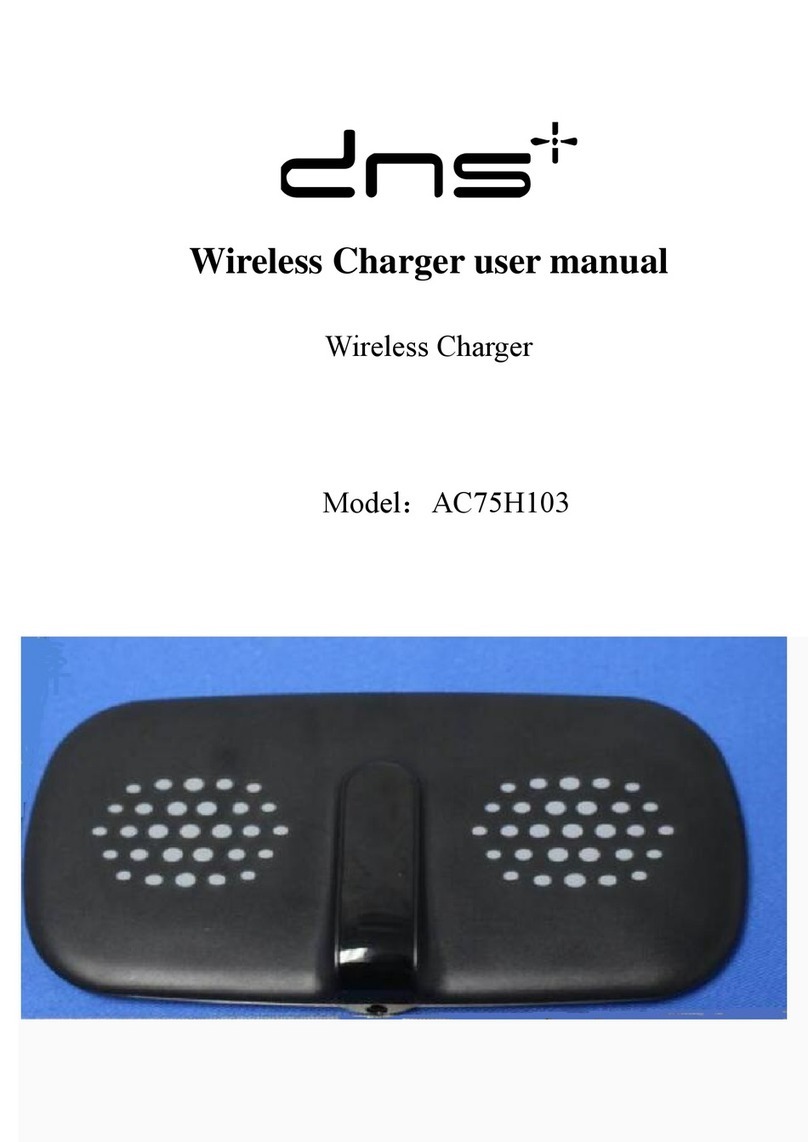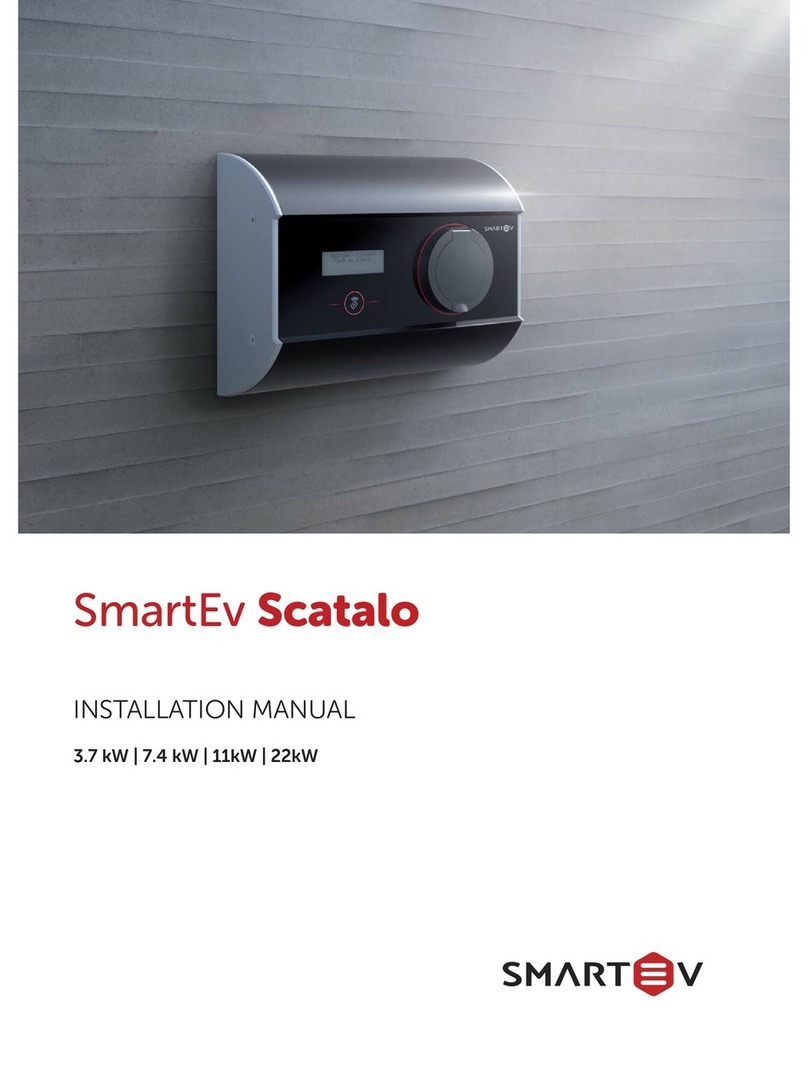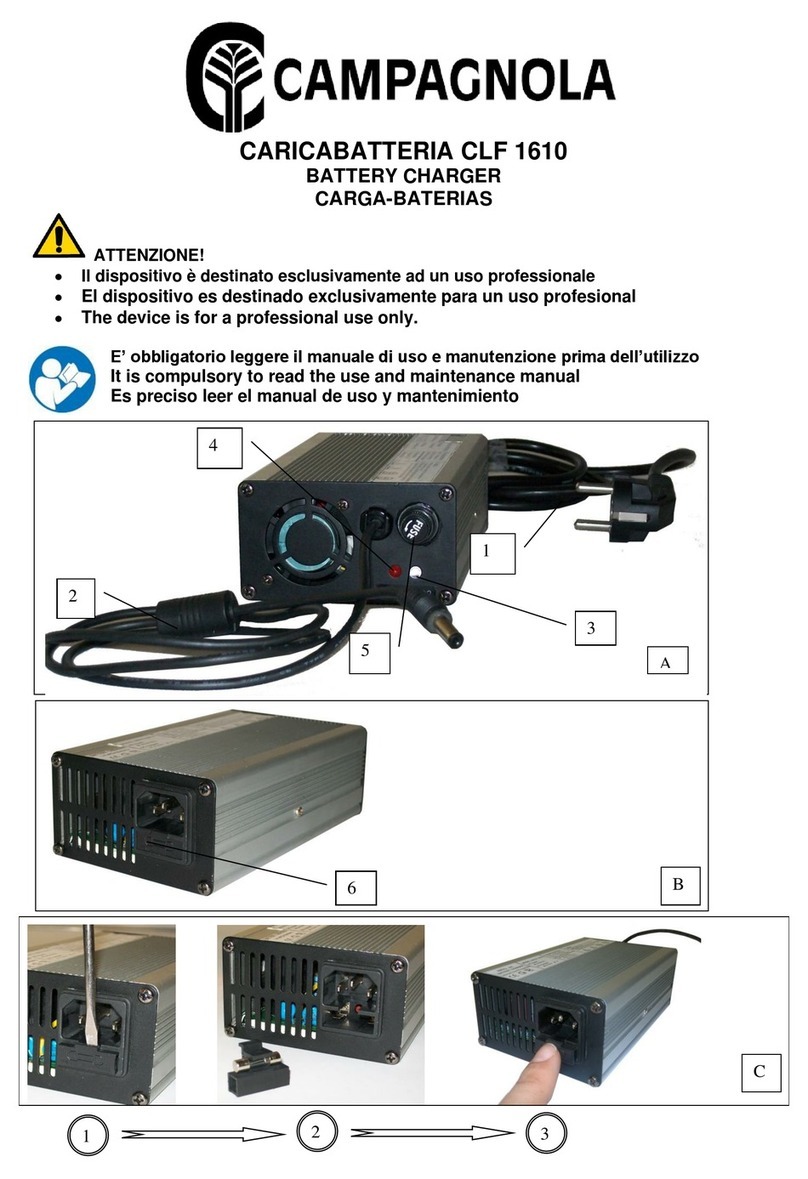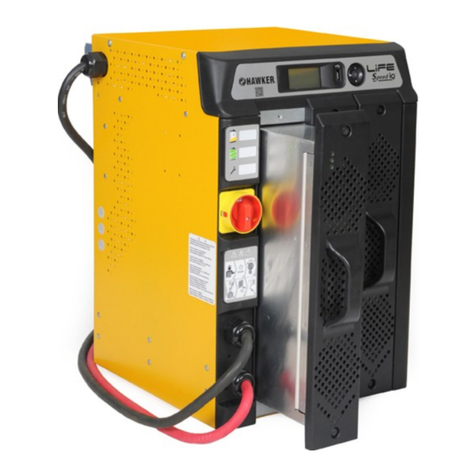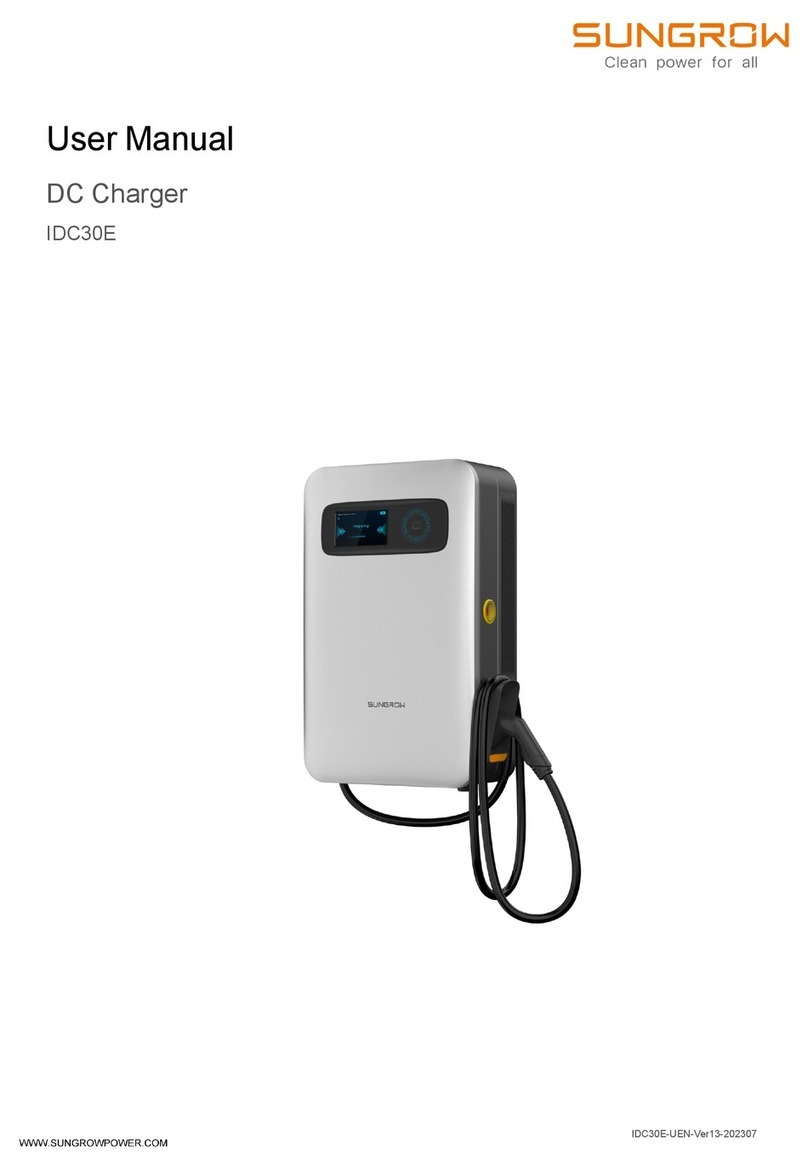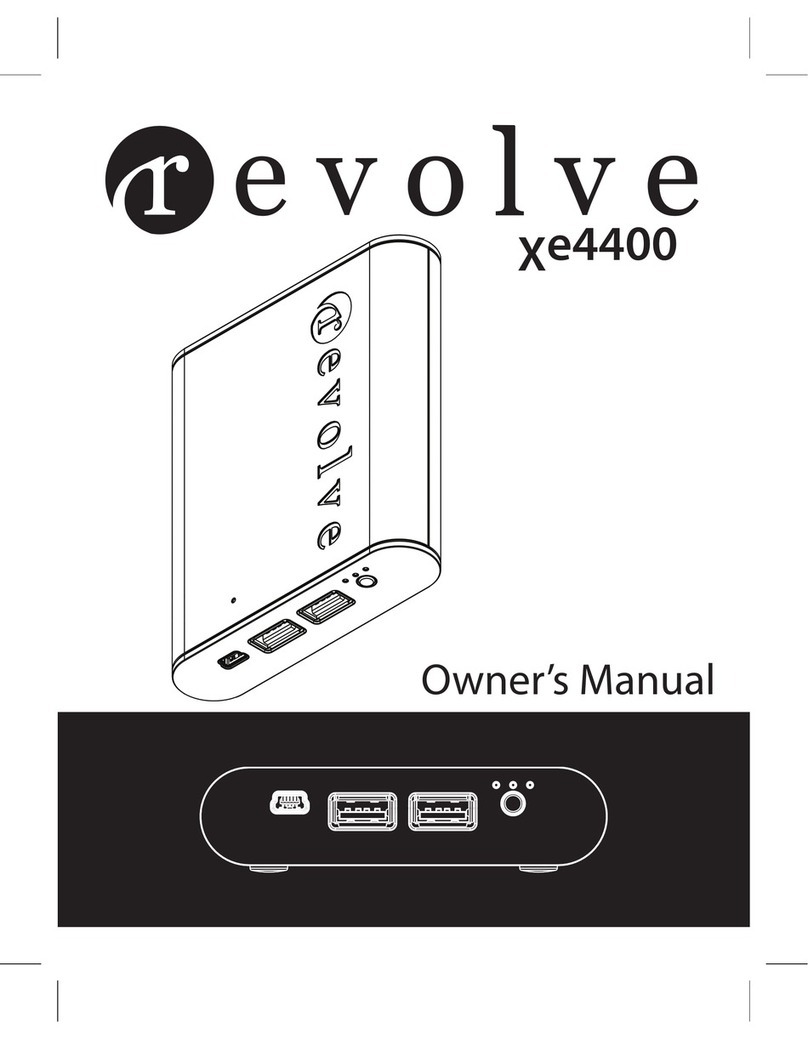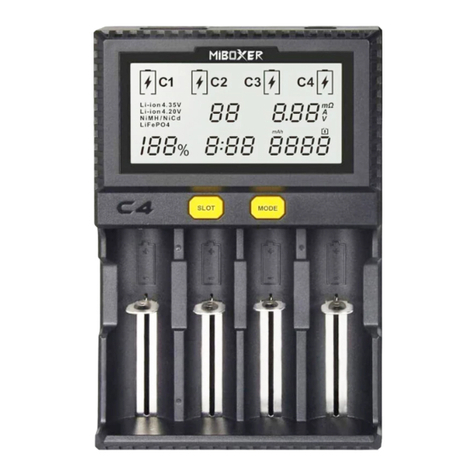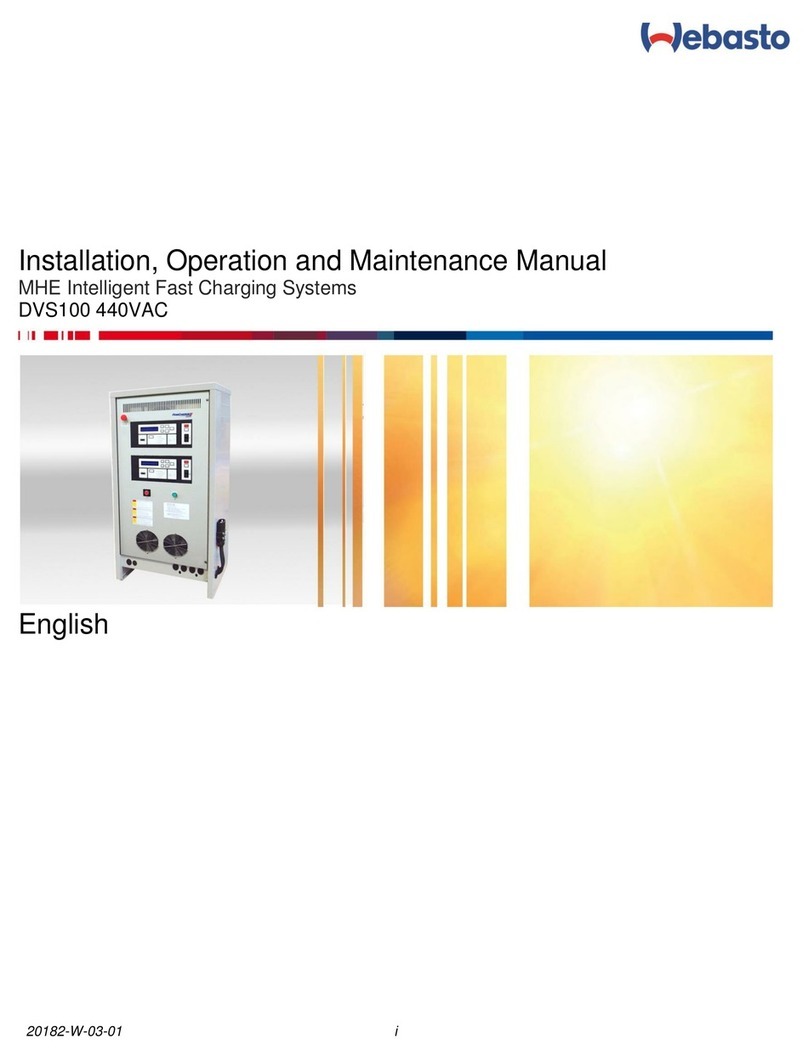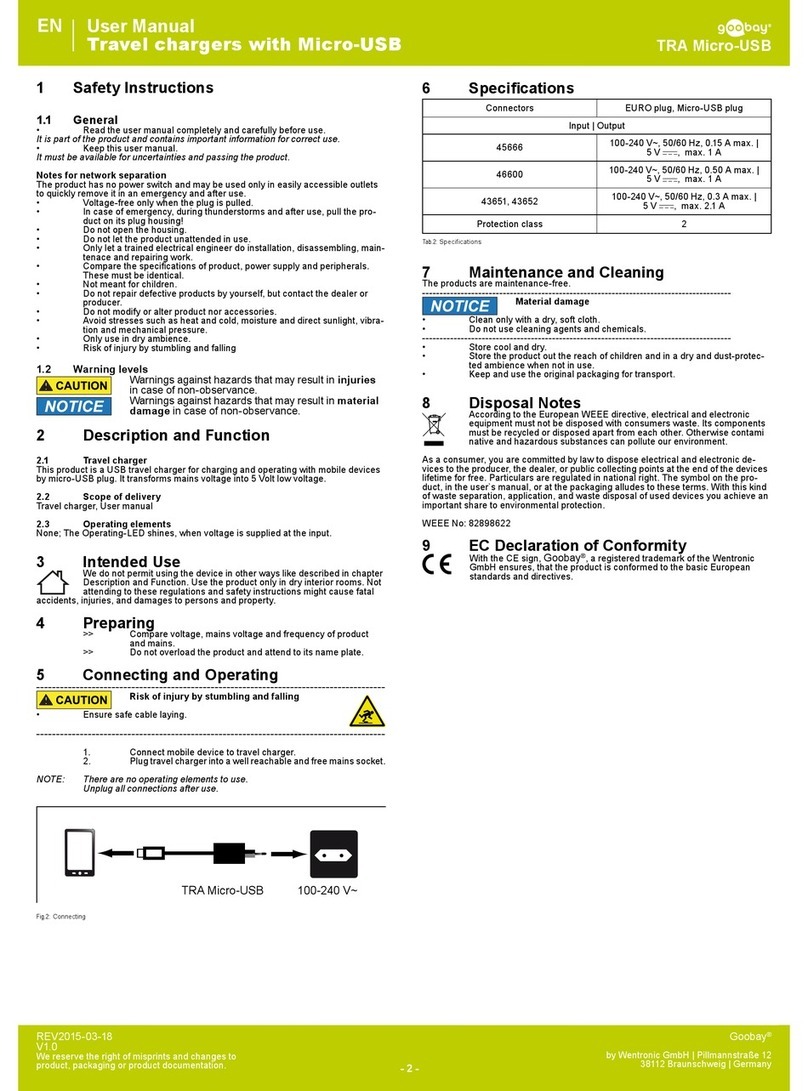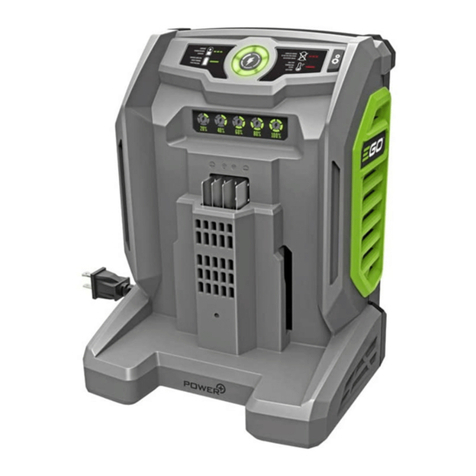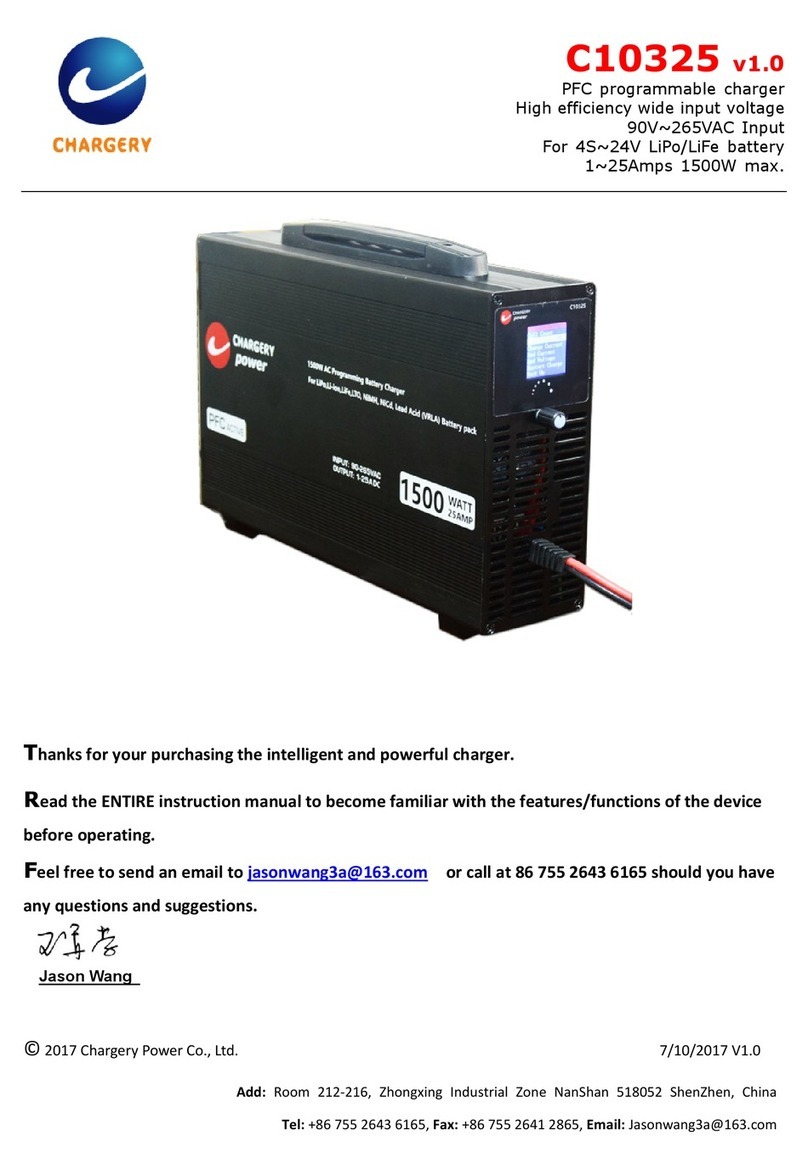ABB Terra HP Generation 3 User manual

Installation manual
Terra HP Generation 3 UL 175 kW Static
DC system
© Copyright ABB. All rights reserved

Copyright
All rights to copyrights, registered trademarks, and trademarks reside with their respective
owners.
Copyright ® ABB EV Infrastructure. All rights reserved.
29AKK107992A3069-EN | 004

Contents
1 About this document.......................................................................... 8
1.1 Function of this document...................................................................................................... 8
1.2 Target group...............................................................................................................................8
1.3 Revision history..........................................................................................................................8
1.4 Language.....................................................................................................................................8
1.5 Illustrations.................................................................................................................................8
1.6 Units of measurement..............................................................................................................8
1.7 Typographical conventions..................................................................................................... 8
1.8 How to use this document...................................................................................................... 8
1.9 General symbols and signal words........................................................................................ 9
1.10 Special symbols for warnings and dangers....................................................................... 10
1.11 Related documents................................................................................................................. 10
1.12 Manufacturer and contact data............................................................................................ 11
1.13 Abbreviations............................................................................................................................11
1.14 Terminology.............................................................................................................................. 12
1.15 Orientation agreements.........................................................................................................13
2 Safety.................................................................................................. 14
2.1 Liability...................................................................................................................................... 14
2.2 General safety instructions................................................................................................... 14
2.3 Required qualifications for the installation person..........................................................14
2.4 Personal protective equipment............................................................................................ 15
2.5 Safety instructions during transport...................................................................................15
2.6 Safety instructions during installation................................................................................15
2.7 Safety instructions for earthing........................................................................................... 16
2.8 Signs on the EVSE....................................................................................................................16
2.9 Discard the EVSE or parts of the EVSE................................................................................ 17
2.10 Cyber security........................................................................................................................... 17
3 Description......................................................................................... 19
3.1 Intended use............................................................................................................................. 19
3.2 Type plate.................................................................................................................................. 19
3.3 General description of the EVSE.......................................................................................... 20
3.4 Working principle.................................................................................................................... 20
3.5 Overview and functions.......................................................................................................... 21
3.5.1 Power cabinet, outside...........................................................................................21
3.5.2 Power cabinet, inside............................................................................................. 22
3.5.3 DC output busbar in a static DC system............................................................ 23
3.5.4 Charge post CP500 Generation 3, outside........................................................ 23
Contents
9AKK107992A3069-EN | 004 3

3.5.5 Charge post CP500 Generation 3, inside........................................................... 24
3.5.6 Overview of the cable glands of the charge post.............................................25
4 Pre-installation.................................................................................. 26
4.1 Pre-installation procedure (site planning)......................................................................... 26
4.2 Prepare the site........................................................................................................................26
4.3 Make sure that the floor space for the EVSE and the airflow around the EVSE is
correct........................................................................................................................................27
4.4 Prepare the foundation.......................................................................................................... 27
4.4.1 Prepare the foundation - general procedure..................................................... 27
4.4.2 Prepare a prefab concrete foundation for the power cabinet.......................27
4.4.3 Prepare a metal foundation for the power cabinet......................................... 28
4.4.4 Prepare a custom foundation for the power cabinet......................................29
4.4.5 Prepare a prefab concrete foundation for the charge post...........................30
4.4.6 Prepare a metal foundation.................................................................................. 31
4.4.7 Prepare a custom foundation for the charge post...........................................31
5 Inspection and transport..................................................................33
5.1 Transport the EVSE to the site............................................................................................. 33
5.2 Inspect the EVSE on delivery................................................................................................. 33
5.3 Do a check on the transport sensors...................................................................................33
5.4 Unpack the EVSE......................................................................................................................33
5.5 Remove the cabinet from the pallet.................................................................................... 34
5.6 Transport the EVSE on the site.............................................................................................34
5.6.1 General transport procedure................................................................................34
5.6.2 Tilt the charge post to the vertical position......................................................35
5.6.3 Move the cabinet with a forklift truck................................................................ 36
5.6.4 Hoist the cabinet.....................................................................................................36
6 Installation......................................................................................... 38
6.1 General installation procedure............................................................................................. 38
6.2 Mechanical installation of the power cabinet....................................................................38
6.2.1 Install the power cabinet - general procedure..................................................38
6.2.2 Install the cabinet on the foundation................................................................. 39
6.2.3 Open the cable inlets .............................................................................................39
6.2.4 Guide the cables to the cabinet...........................................................................40
6.2.5 Close the cable inlets ............................................................................................ 40
6.2.6 Install the front cover plate (concrete foundation).........................................40
6.2.7 Install the cover plates (metal foundation)....................................................... 41
6.3 Mechanical installation of the charge post........................................................................ 41
6.3.1 Install the charge post - general procedure.......................................................41
6.3.2 Remove the cable gland plates............................................................................ 42
6.3.3 Install the charge post on the foundation......................................................... 43
Contents
49AKK107992A3069-EN | 004

6.3.4 Install the cable gland plates................................................................................43
7 Electrical installation of the power cabinet.................................. 44
7.1 General procedure...................................................................................................................44
7.2 Connect the PE cables to the power cabinet.....................................................................44
7.3 Connect the AC input cables.................................................................................................45
7.4 Connect the DC power cables...............................................................................................46
7.5 Connect the AC auxiliary power cable in the primary power cabinet........................... 47
7.6 Connect the interlock and DC guard cables to the power cabinet............................... 48
7.7 Connect the optical CAN cable between the power cabinet and the charge post....49
8 Electrical installation of the charge post.......................................50
8.1 General procedure...................................................................................................................50
8.2 Connect the PE wires..............................................................................................................50
8.3 Connect the DC power input cables.....................................................................................51
8.4 Connect the AC auxiliary power cable................................................................................. 52
8.5 Connect the interlock and DC guard cable.........................................................................53
8.6 Connect the optical CAN cable............................................................................................. 54
8.7 Connect the Ethernet cable...................................................................................................55
9 Prepare for commissioning..............................................................57
10 Access to parts.................................................................................. 58
10.1 Open the door of the power cabinet...................................................................................58
10.2 Remove the plinth covers of the power cabinet............................................................... 58
10.3 Remove the DC busbar cover................................................................................................59
10.4 Remove the AC covers............................................................................................................ 59
10.5 Close the door of the power cabinet.................................................................................. 60
10.6 Open the door of the charge post........................................................................................61
10.7 Remove the plinth covers of the charge post.................................................................... 61
10.8 Remove the protection plate of the charge post..............................................................62
10.9 Close the door of the charge post....................................................................................... 62
11 Generic procedures...........................................................................64
11.1 Install a cable lug on a wire................................................................................................... 64
11.2 Install a ferrule on a wire........................................................................................................64
11.3 Install insulating heatshrink tubing on a wire................................................................... 65
11.4 Connect a wire that has a cable lug.....................................................................................66
11.5 Connect a wire that has a ferrule......................................................................................... 66
Contents
9AKK107992A3069-EN | 004 5

12 Technical data....................................................................................67
12.1 EVSE type.................................................................................................................................. 67
12.2 Parts included in the delivery................................................................................................ 67
12.3 Required tools for installation..............................................................................................68
12.4 Required parts for installation............................................................................................. 68
12.5 General specifications............................................................................................................69
12.6 Electrical installation specifications (North America)..................................................... 69
12.7 Electrical installation specifications (Canada)..................................................................70
12.8 DC output specifications.......................................................................................................70
12.9 Current peaks during the start of a charge session (DC output).................................. 71
12.10 Logic interfaces specifications.............................................................................................71
12.11 Mass and center of gravity.................................................................................................... 72
12.11.1 Mass........................................................................................................................... 72
12.11.2 Center of gravity, power cabinet......................................................................... 72
12.11.3 Center of gravity, charge post..............................................................................73
12.12 Ambient conditions.................................................................................................................73
12.13 Noise level................................................................................................................................. 74
12.14 Torque specifications.............................................................................................................74
12.15 Dimensions............................................................................................................................... 74
12.15.1 Power cabinet.......................................................................................................... 74
12.15.2 Charge post..............................................................................................................75
12.15.3 Height of user operable elements....................................................................... 76
12.16 Space requirements................................................................................................................ 77
12.16.1 Power cabinet.......................................................................................................... 77
12.16.2 Charge post..............................................................................................................78
12.16.3 Charge post: exceptions for bollards and other minor fixed obstacles......79
12.16.4 Distance requirements between power cabinet and charge post............... 80
12.17 Foundation specifications.................................................................................................... 80
12.17.1 Power cabinet (prefab concrete).........................................................................80
12.17.2 Power cabinet (metal frame)................................................................................84
12.17.3 Gland plates for the metal foundation of the power cabinet........................85
12.17.4 Power cabinet (custom)........................................................................................ 86
12.17.5 Charge post (prefab concrete).............................................................................87
12.17.6 Charge post (metal frame)................................................................................... 90
12.17.7 Gland plates for the metal foundation of the charge post.............................91
12.17.8 Charge post (custom)............................................................................................92
12.18 Overview of the cable conduits............................................................................................ 93
12.19 Cable specifications................................................................................................................95
12.19.1 AC input cable for the power cabinet................................................................. 95
12.19.2 DC power installation cables ...............................................................................95
12.19.3 PE cable.....................................................................................................................96
12.19.4 AC auxiliary power cables......................................................................................96
12.19.5 Interlock and DC guard cables..............................................................................97
Contents
69AKK107992A3069-EN | 004

12.19.6 Optical CAN cables between the power cabinet and the charge post........ 97
12.19.7 Ethernet cable..........................................................................................................97
12.20 Expected wye input.................................................................................................................98
12.21 Electrical connection diagram.............................................................................................. 99
Contents
9AKK107992A3069-EN | 004 7

1 About this document
1.1 Function of this document
The document is only applicable for this EVSE: Terra HP Generation 3, including the
variants and options listed in section 12.1.
The document gives the information that is necessary to install the EVSE.
1.2 Target group
The document is intended for qualified installation persons.
For a description of the required qualifications, refer to section 2.3.
1.3 Revision history
Version Date Description
001 March 2021 Initial version
002 May 2021 Updates
003 July 2021 Updates
004 November 2021 Updates
1.4 Language
The original instructions of this document are in English (EN-US). All other language
versions are translations of the original instructions.
1.5 Illustrations
It is not always possible to show the configuration of your EVSE. The illustrations in
this document show a typical setup. They are for instruction and description only.
1.6 Units of measurement
SI units of measurement (metric system) are used. If necessary, the document
shows other units between parentheses () or in separate columns in tables.
1.7 Typographical conventions
The lists and steps in procedures have numbers (123) or letters (abc) if the sequence
is important.
1.8 How to use this document
1. Make sure that you know the structure and contents of this document.
2. Read the safety chapter and make sure that you know all the instructions.
About this document
89AKK107992A3069-EN | 004

3. Do the steps in the procedures fully and in the correct sequence.
4. Keep the document in a safe location that you can easily access. This document
is a part of the EVSE.
1.9 General symbols and signal words
Signal word Description Symbol
Danger If you do not obey the instruction, this
can cause injury or death.
Refer to section
1.10.
Warning If you do not obey the instruction, this
can cause injury.
Refer to section
1.10.
Caution If you do not obey the instruction, this
can cause damage to the EVSE or to
property.
Note A note gives more data, to make it easier
to do the steps, for example.
- Information about the condition of the
EVSE before you start the procedure.
- Requirements for personnel for a proce-
dure.
- General safety instructions for a proce-
dure.
- Information about spare parts that are
necessary for a procedure.
- Information about support equipment
that is necessary for a procedure.
- Information about supplies (consuma-
bles) that are necessary for a procedure.
- Make sure that the power supply to the
EVSE is disconnected.
About this document
9AKK107992A3069-EN | 004 9

Signal word Description Symbol
- Electrotechnical expertise is required,
according to the local rules.
- Alternating current supply
Note: It is possible that not all symbols or signal words are present in
this document.
1.10 Special symbols for warnings and dangers
Symbol Risk type
General risk
Hazardous voltage that gives risk of electrocution
Risk of pinching or crushing of body parts
Rotating parts that can cause a risk of entrapment
Hot surface that gives risk of burn injuries
Note: It is possible that not all symbols are present in this document.
1.11 Related documents
Document name Target group
Product data sheet All target groups
Installation manual Qualified installation person
User manual Owner
About this document
10 9AKK107992A3069-EN | 004

Document name Target group
Service manual Qualified service engineer
Declaration of conformity (CE) All target groups
1.12 Manufacturer and contact data
Manufacturer
ABB EV Infrastructure
George Hintzenweg 81
3068 AX, Rotterdam
The Netherlands
Contact data
ABB EV Infrastructure in your country can give you support on the EVSE. You can
find the contact data here: https://new.abb.com/ev-charging
1.13 Abbreviations
Abbreviation Definition
AC Alternating current
BESS Battery energy storage system
CAN Controller area network
CPU Central processing unit
DC Direct current
EMC Electromagnetic compatibility
EV Electric vehicle
EVSE Electric vehicle supply equipment
MID Measuring Instruments Directive
NFC Near field communication
NoBo Notified body
OCPP Open charge point protocol
PE Protective earth
PPE Personal protective equipment
RFID Radio-frequency identification
Note: It is possible that not all abbreviations are present in this
document.
About this document
9AKK107992A3069-EN | 004 11

1.14 Terminology
Term Definition
Network operating center
of ABB EV Infrastructure
Facility of the manufacturer to do a remote check on
the correct operation of the EVSE
Cabinet Enclosure of the EVSE, including the components on
the inside
Cable slack Extra length of cable from the top of the foundation so
that the cable length is sufficient to connect to the
correct terminal in the cabinet
CCS Combined Charging System, a standard charging
method for electric vehicles
CHAdeMO Abbreviation of
CHArge de MOve
, a standard charging
method for electric vehicles
Contractor Third party that the owner or site operator hires to do
engineering, civil and electrical installation work
Grid provider Company that is responsible for the transport and dis-
tribution of electricity
Local rules All rules that apply to the EVSE during the entire lifecy-
cle of the EVSE. The local rules also include the national
laws and regulations
Open charge point proto-
col
Open standard for communication with charge sta-
tions
Owner Legal owner of the EVSE
Site operator Entity that is responsible for the day-to-day control of
the EVSE. The site operator does not have to be the
owner
User Owner of an EV, who uses the EVSE to charge the EV
Note: It is possible that not all terms are present in this document.
About this document
12 9AKK107992A3069-EN | 004

1.15 Orientation agreements
A
B
D
C
A
BD
XY
Z
C
A Front side: face forward to the
EVSE during normal use
B Left side
C Right side
D Rear side
X X-direction (positive is to the right)
Y Y-direction (positive is rearward)
Z Z-direction (positive is upward)
About this document
9AKK107992A3069-EN | 004 13

2 Safety
2.1 Liability
The manufacturer is not liable to the purchaser of the EVSE or to third parties for
damages, losses, costs or expenses incurred by the purchaser or third parties if any
target group mentioned in the related documents does not obey the rules below:
• Obey the instructions in the related documents. Refer to section 1.11.
• Do not misuse or abuse the EVSE.
• Only make changes to the EVSE, if the manufacturer approves in writing of the
changes.
2.2 General safety instructions
• This document, the related documents and the warnings included do not
replace your responsibility to use your common sense when you do work on the
EVSE.
• Only do the procedures that the related documents show and that you are
qualified for.
• Obey the local rules and the instructions in this manual. If the local rules
contradict the instructions in this manual, the local rules will apply.
If and to the extent permitted by law, in case of inconsistency or contradiction,
between any requirements or procedure contained in this document and any
such local rules, obey the stricter between the requirements and procedures
specified in this document and the local rules.
2.3 Required qualifications for the installation person
• The qualified installation person knows the EVSE and its safe installation.
• The installation person is qualified according to the applicable local rules to do
the work.
• The qualified installation person obeys all local rules and the instructions in the
installation manual.
• It is the responsibility of the owner of the EVSE to make sure that all qualified
installation persons obey the local rules, the installation instructions, and the
specifications of the EVSE.
Safety
14 9AKK107992A3069-EN | 004

2.4 Personal protective equipment
Symbol Description
Protective clothing
Safety gloves
Safety shoes
Safety glasses
2.5 Safety instructions during transport
Preliminary requirements
1. Installation engineer •
• Make sure that the hoisting equipment or forklift truck can lift the EVSE safely.
Take into account the mass and the center of gravity of the EVSE.
• Obey the safety instructions that apply to the hoisting equipment or the forklift
truck.
• Put on the correct personal protective equipment. Refer to section 2.4.
2.6 Safety instructions during installation
Preliminary requirements
1.
Installation engineer
•
• Make sure that there is no voltage on the AC input cables during the complete
installation procedure.
• Keep unqualified personnel at a safe distance during installation.
• Only use electrical wires of sufficient gauge and insulation to handle the rated
current and voltage demand.
Safety
9AKK107992A3069-EN | 004 15

• Make sure that the load capacity of the grid is in accordance with the EVSE.
• Earth the EVSE correctly. Refer to section 2.7.
• Make sure that the wiring inside the EVSE is protected from damage and cannot
get trapped when you open or close the cabinet.
• Make sure that water cannot enter the cabinet.
• Protect the EVSE with safety devices and measures that the local rules specify.
• If it is necessary to remove safety devices, immediately install the safety devices
after the work.
• Put on the correct personal protective equipment. Refer to section 2.4.
2.7 Safety instructions for earthing
Preliminary requirements
•
• Make sure that the EVSE is connected to a grounded, metal, permanent wiring
system, or an equipment-grounding conductor must be run with the circuit
conductors and connected to the equipment grounding terminal or lead on the
product.
• Make sure that the connections to the EVSE comply with all applicable local
rules.
2.8 Signs on the EVSE
Symbol Risk type
General risk
Hazardous voltage that gives risk of electrocution
Risk of pinching or crushing of body parts
Rotating parts that can cause a risk of entrapment
Hot surface that gives risk of burn injuries
Safety
16 9AKK107992A3069-EN | 004

Symbol Risk type
PE
Sign that means that you must read the manual before
you install the EVSE
Waste from electrical and electronic equipment
Note: It is possible that not all symbols are present on the EVSE.
2.9 Discard the EVSE or parts of the EVSE
Incorrect waste handling can have a negative effect on the environment and human
health due to potential hazardous substances. With the correct disposal of this
product, you contribute to reuse and recycling of materials and protection of the
environment.
• Obey the local rules to discard parts, packaging material or the EVSE.
• Discard electrical and electronic equipment separately in compliance with the
WEEE - 2012/19/EU Directive on waste of electrical and electronic equipment.
• As the symbol of the crossed out wheeled-bin on your EVSE indicates, do not
mix or dispose the EVSE with your household waste, at the end of use. Instead,
hand the EVSE over to your local community waste collection point for recycling.
• For more information, contact the Government Waste-Disposal department in
your country.
2.10 Cyber security
Note: This topic is valid for a wired Ethernet connection.
This product is designed to be connected to and to communicate information and
data via a network interface. It is the Owner's sole responsibility to provide and
continuously ensure a secure connection between the product and Owner's network
or any other network (as the case may be).
The Owner shall establish and maintain any appropriate measures (such as but not
limited to the installation of firewalls, application of authentication measures,
encryption of data, installation of anti-virus programs, etc) to protect the product,
the network, its system and the interface against any kind of security breaches,
unauthorized access, interference, intrusion, leakage and/or theft of data or
information.
Safety
9AKK107992A3069-EN | 004 17

ABB Ltd and its affiliates are not liable for damages and/or losses related to such
security breaches, any unauthorized access, interference, intrusion, leakage and/or
theft of data or information.
Safety
18 9AKK107992A3069-EN | 004

3 Description
3.1 Intended use
The EVSE is intended for DC high power charging of EVs. The EVSE is intended for
indoor or outdoor use.
• The properties of the electrical grid, the ambient conditions and the EV must
comply with the technical data of the EVSE. Refer to chapter 12.
• Only use the EVSE with accessories that are approved by the manufacturer (ABB
EV Infrastructure) and that obey the local rules.
• Do not use power cabinets from this EVSE with power cabinets from different
EVSEs.
Danger:
General risk
• If you use the EVSE in any other way than described in the related
documents, you can cause death, injury and damage.
• Use the EVSE only as intended.
3.2 Type plate
XX XXXXXX XX
SAP PN XXXXXXXXXXXX
GLOBAL ID XXXXXXXXXX
SN XXXX-XXX-XXXX-XXX
FOR USE WITH ELECTRICAL VEHICLES
XXXX xxx-xxxV MAX XXXA
XXXXX xxx/xxxV XW+PE ~
XXXXX XXXX xxx-xxxV
XXXXX XXXX xxx-xxxV
XXX x.xkW/xxHz
XXXX xxxA
XXXX xxxA
XXXX XX xxV xA
ABB B.V.
George Hintzenweg 81,
3068 AX Rotterdam,
The Nederlands
MADE IN ITALY Contains FCC ID (see note A): XXXXXXXXX; XXXXXXX Prod. date xx xxxx
Weight XXX Kg SN
GLOBAL ID
Refer to manual Rainproof
TUV Rheinland
A
B
C
D
E
G
H
I
F
J
K
L
M
A Manufacturer
B Full EVSE type
C Part number of the EVSE
D Serial number
E Internal product code (for the
manufacturer)
F EVSE mass
G EVSE rating
H Address of the manufacturer
I UL mark
J QR code with the internal product
code (for the manufacturer)
K QR code with the serial number of
the EVSE
L Additional EVSE rating data
M Production date
Description
9AKK107992A3069-EN | 004 19

Note: The data in the illustration are only examples. Find the type plate
on your EVSE to see the applicable data. Refer to section 3.5.4.
3.3 General description of the EVSE
The EVSE is an arrangement of these parts:
• Distribution board
• Power cabinet
• Charge post
An arrangement can have one or more power cabinets and one or more charge
posts. For the specifications of the configuration in this manual, refer to section
3.4.
3.4 Working principle
Note: For a detailed overview of all electrical connections, refer to
section 12.21.
B
D
A
CU
CCB
E
C
CCB
F
IMI
CPI
A Distribution board
B Power cabinet
C Charge post
D Surge protection device
E Power module (x3)
F EV charge cable
Description
20 9AKK107992A3069-EN | 004
This manual suits for next models
2
Table of contents
Other ABB Batteries Charger manuals

